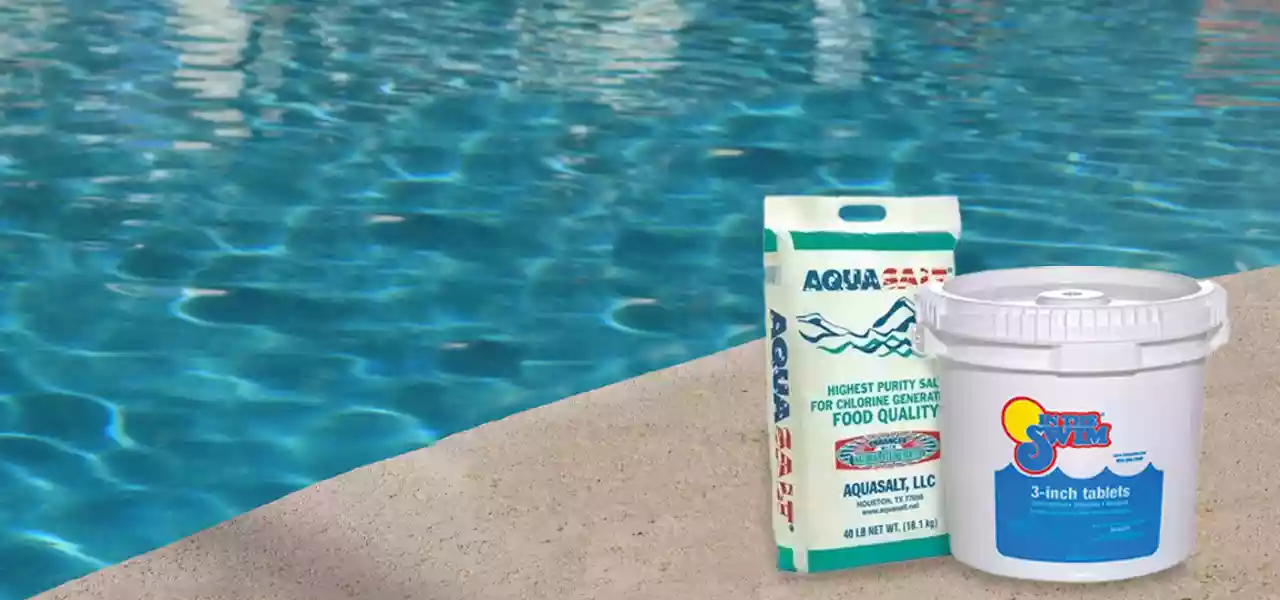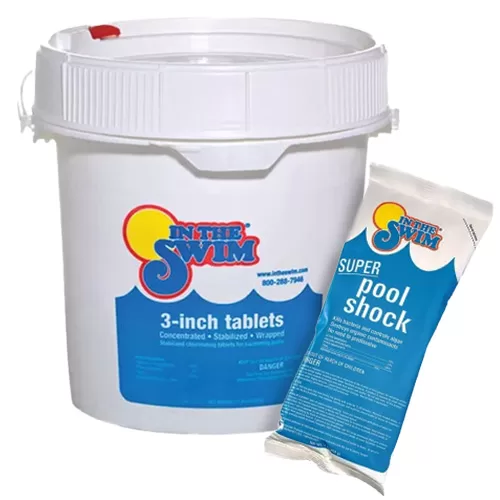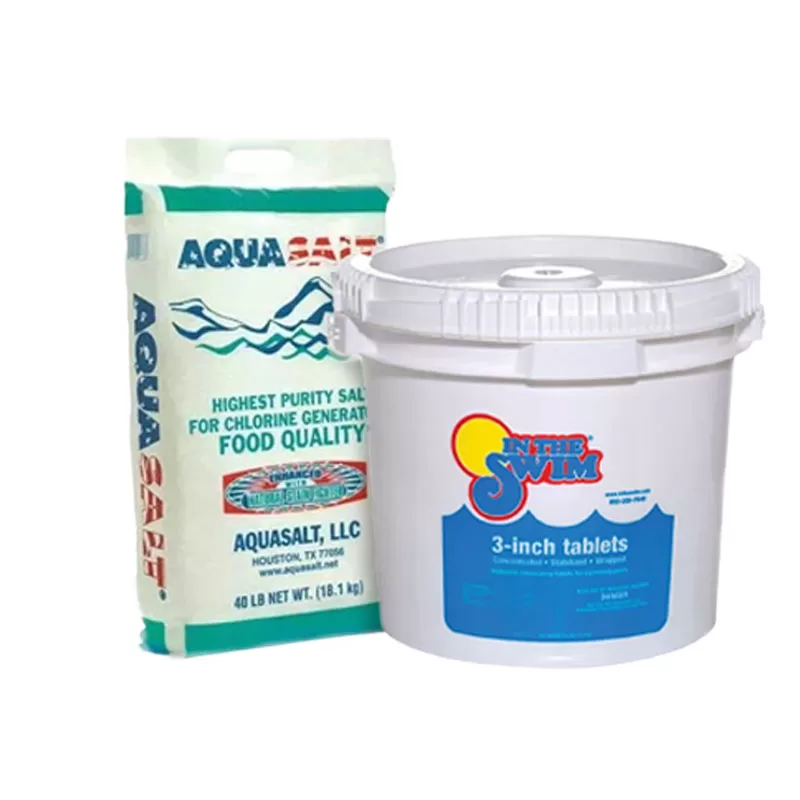FREE Standard Shipping On All Orders $100 or More!*

Saltwater vs. Chlorine Pools
One of the most important things to keep in mind when buying a pool or maintaining the one you’ve got is keeping the water sanitized, healthy, and safe for your family. Whether you had a pool growing up, or are brand new to the subject, most people rank chlorine as the top form of pool water sanitization. However, the saltwater vs. chlorine pool is a popular discussion among pool owners. So let's dive into the differences between salt chlorinators and chlorine tablets, and decide if one really is better than the other.
Why Pools Need Chlorine

Chlorine is the most effective agent in the battle against any and all pool water contaminants, like bacteria, animal droppings, cosmetics, and detergents. The powerful sanitizer effectively attaches to and neutralizes bacteria and contaminants before they can take root and disturb your pool water balance.
Chlorine also combines with other unnatural contaminants, such as nitrogen and ammonia, and transforms into "combined chlorine". Combined chlorine, better known as "chloramines", is responsible for the overwhelming chemical smell often found at public pools. While you may think this smell indicates clean and sanitized water, that couldn't be further from the truth. Because chloramines develop when chlorine combines with ammonia — which drastically reduces chlorine's effectiveness — they are indicative of poorly sanitized water.
Thankfully, chloramines are easy to diagnose and remove. Test your pool water frequently with a test kit or test strips, and shock your pool if chloramines are present.
Types of Chlorine
Chlorine typically comes in three forms, tablets, granules, and liquid. While all forms provide your pool with excellent cleaning powers, certain situations may call for the use of one form in particular.
Chlorine Tablets
Tablets are the most popular form of chlorine used by pool owners, thanks to their convenience and efficiency. Most chlorine tablets are slow-dissolving, which means they provide your pool with a slow, consistent dose of chlorine — avoiding any gaps in sanitization. Tablets are the ideal size and shape for handy chlorine floaters or automatic feeders.
Additionally, most chlorine tablets are stabilized and contain the important Cyanuric Acid. Much like the sunscreen we use, Cyanuric Acid protects the chlorine molecules from the sun's UV rays.
Granular Chlorine

Granulated chlorine is often used as pool shock, but can also be used for routine chlorination. Sodium dichlor is the most common type of everyday granular chlorine and also contains Cyanuric Acid. And when it comes to granulated shock, Calcium Hypochlorite (cal-hypo) reigns supreme. Cal-hypo contains high levels of chlorine and is the most powerful form of pool shock.
Chlorine users need to stay on top of their water testing, as the pH can fluctuate quite a bit. Heavy bather loads and weather can wreak havoc on a pool's water balance. Chlorine shock can provide a much faster solution to your problem. Let’s recap the pros and cons of chlorine.
Tablets & Granular Pros
- Easy to use
- Fast acting granular is best for shocking
- Tablets are stabilized protecting your chlorine from the sun
- Sanitizes your pool even if your pump and filter aren’t running
- Works in any temperature
Tablets & Granular Cons
- Harsh on rails and equipment like pool heaters
- Dangerous to handle and store
- Calcium shock can cause calcium build up
- Stabilized chlorine can cause cyanuric acid build up
Saltwater Chlorination
Instead of continuously buying chlorine products, you can invest in a saltwater chlorine generator, also called a salt system, which transforms salt into chlorine. It’s like bringing a small chlorine factory to your home!
How Saltwater Chlorine Generators Work
First, simply add the designated amount of pool salt to your pool water. Once the salt level is established, the chlorine generator does the rest. As water passes through the salt cell, the salt goes through a process called electrolysis, which converts the salt or sodium chloride (NaCl2) to sodium hypochlorite (NaOCl). The sodium hypochlorite then converts to pure chlorine (hypochlorous acid)!
How Much Salt Do You Need?
Most pools require hundreds of pounds of pool salt for the initial dose, but after that you may just need the occasional maintenance dosage, as the saltwater gets splashed out, evaporates, or backwashed away over time. The initial amount of salt needed depends on the volume of your pool and the requirements of your saltwater chlorine generator. On average, a 40-pound bag of pool salt is sufficient for 2,000 gallons of pool water.
Types of Salt Systems
There are many types of inground salt systems, but one of the most popular models is the Hayward AquaRite. While the different models and brands vary slightly in their design and capabilities, they all share standard characteristics. All salt systems have a weatherproof box that's hung on a wall by your equipment which includes the power supply, controller, and salt cell, which is plumbed into your return line.
Salt systems include a flow switch which is basically a PVC Tee that plumbs before the salt cell and connects to your power supply. The sensors also measure water temperature and salt level.
Salt controllers feature a digital display for chlorine production level, salt level, error codes, on-off switch, a dial to adjust chlorine production, and a super chlorinate switch to boost chlorine output. Inground salt chlorinators, like the Pentair IntelliChlor, have the controller built into the cell, so you can make your adjustments right at the cell.
Above ground salt chlorinators are designed for quick installation and simply hang over the pool wall just under the top seat inside the pool and plug into a wall mountable control box and standard electrical outlet like the AquaTrol by Hayward and Solaxx Saltron Retro.
Benefits of a Salt System
The initial set up of a salt system is much more costly than a chlorine pool but the system does have quite a few advantages. The overwhelming chemical smell caused by chloramines is almost nonexistent. Plus, with a salt pool you also get a silky feeling on the skin and the water is really easy on the eyes.
But keep in mind that the salt system does not take care of everything. You still need to test your water balance and salt levels, and make chemical adjustments based on your readings. There is a little maintenance on the equipment too, your salt cell may need occasional cleaning, and having to replace a salt cell (every 3–5 yrs) is not cheap.
Here are some of the ups and downs you might find with a salt system:
Salt System Pros
- Non-hazardous materials
- Many new models have a self-cleaning feature
- Silky feeling of the water is easy on the skin and eyes
- Salt tends to buffer pH and alkalinity, keeping them steady
- No need to handle chlorine
- Once operational, sanitizer maintenance is reduced
Salt System Cons
- Expensive start-up costs
- 500+ lbs of salt is required
- Cold water halts chlorine production
- Repair and replacement parts can be costly
- Pump needs to run for chlorine to be created
- You still need liquid or granular to shock the pool
Chlorine Tablet Chlorination vs. Salt Chlorination
Pool pH Levels: Tablets are low in pH and may lower your pool water pH level, which may require additions of pH increaser to maintain suitable pool pH levels.
Salt chlorinators create sodium hypochlorite, which is high in pH so it will be necessary to add an Acid to balance it out - in most cases on a weekly basis, to bring the pH level down into proper range.

Maintenance: Another thing to factor in is the maintenance and reliability of your choice. With the salt system you must initially invest in the system and have it installed, purchase the salt, and stock up on pH reducer and stabilizer.
The salt level must be maintained and the salt cell must be periodically cleaned. Additionally, at some point, you'll need a replacement salt cell.
Another thing about salt is that at high levels it can be corrosive and take its toll on anything metal in your pool. Using sacrificial anodes is the best way to protect your pool light, ladders, and heater cores. They are easy to install and are designed to corrode so your other accessories and equipment don’t.
Cost: A regular chlorine user will spend less up front but probably spend about the same amount in buckets of tablets, other maintenance chemicals, floaters and feeders in the same time period. After that you must keep on buying these things.
A salt system user will pay more up front, but very little over the year. Salt chlorination can pay for itself relative to the expense of chlorine tablet usage in about 5 years. After that, you are home free, as long as the controller and salt cell keep working.
Saltwater vs. Chlorine Tablet Cost Comparison
In comparing chlorine tablet cost to the cost of a salt system, we assume equal costs for balancing chemicals, cyanuric acid, clarifiers or algaecides.
Cost of Using a Salt Chlorinator
- Hayward AquaRite Salt System or AquaTrol Salt System
- Salt test strips
- Initial salt treatment
- Annual salt boosters
- Salt cell replacement
- Annual pool shock

Total: $1910 for ten years of salt chlorination. This assumes using granular pool shock twice per year, at opening and closing times, although you may need more. It also assumes replacing the salt cell once, at 5 years, although it’s possible it won’t last that long. Most properly maintained T-Cells will last 3-5 years. It also assumes no control board problems, and no draining of the pool, which requires a new salt treatment.
NOTE: a salt system only makes chlorine if the pump and filter are operational, and there are no issues in the controller, sensors, or salt cell. Any technical difficulties in these areas will require supplemental tablets/shock to maintain water clarity and prevent algae.
Cost of Using Chlorine Tablets
- Chlorinator or chlorine floater
- Chlorine tablets – 50 lbs/yr
- Pool shock – 24 lbs/yr
- Chlorinator replacement
The total cost for 10 years of chlorine tablet use is roughly $2,000. This assumes using granular shock monthly, and 5 tablets weekly, although you may use less. It also assumes replacing the chlorinator or several parts at least once during ten years.
Your salt system is reliable as long as it's clean, there is electricity, and the pump and filter work. The other forms of chlorine are tried and true methods of pool maintenance, but require keeping an eye on your supply and applying the chlorine at regularly.
So to summarize, salt systems are a great way to automate your pool sanitizing but require a sizable up-front investment, require installation, and are expensive to replace. Traditional chlorine tablets and granules, although less expensive to start, require annual or multiple in season purchases, trips and transporting to and from the store, manual loading of feeders and floaters, and more attention to keeping appropriate levels in the pool...
And the winner is...
Looks like both chlorine and salt went 12 rounds, and the winner by decision is...Chlorine! However, both methods of chlorination have very convincing pros and cons.
Both of these methods are effective and safe, simple, and smart so either way you go you can be sure your family will enjoy a sanitized, sparkling, and safe swimming pool this summer!